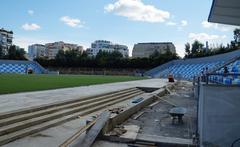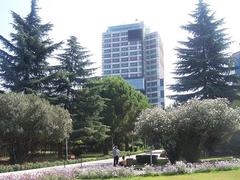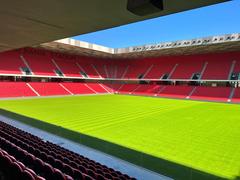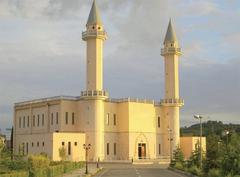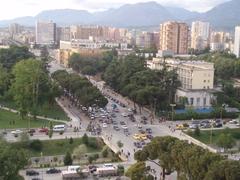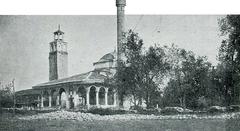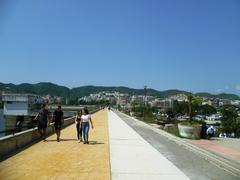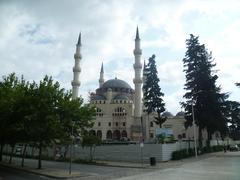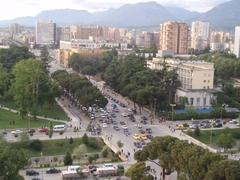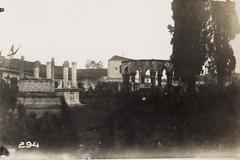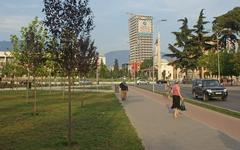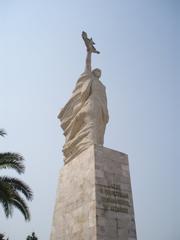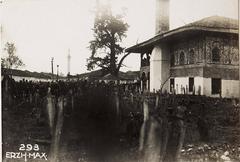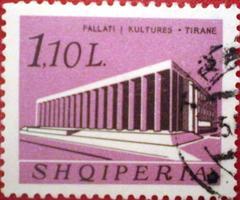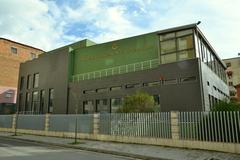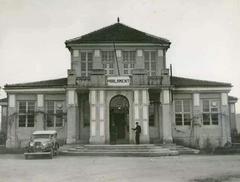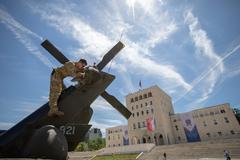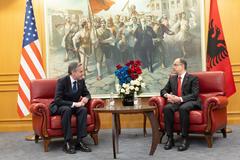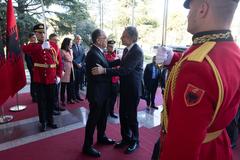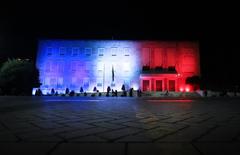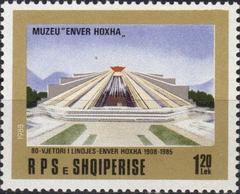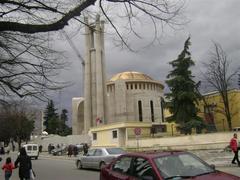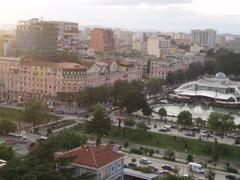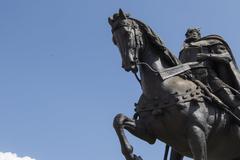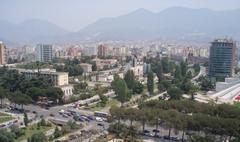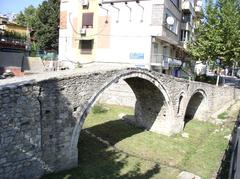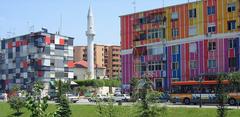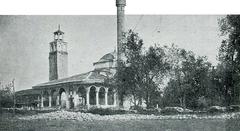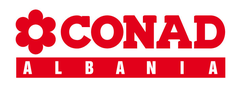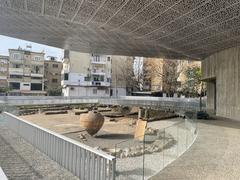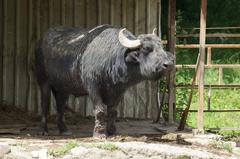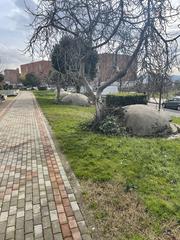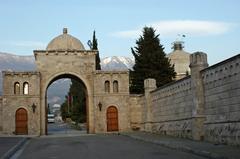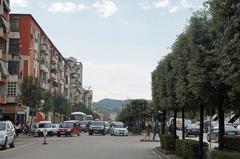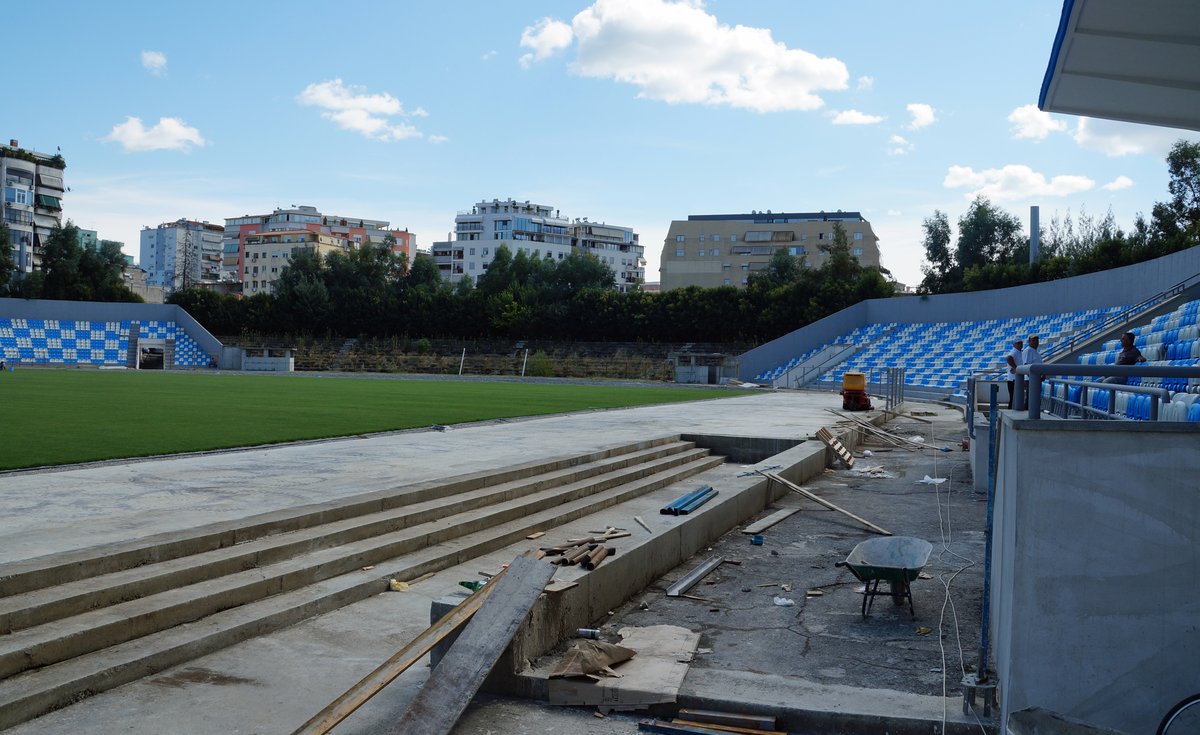
Selman Stërmasi Stadium: Visiting Hours, Tickets, and Travel Guide to Tirana’s Historic Football Landmark
Date: 14/06/2025
Introduction
Selman Stërmasi Stadium is not only a central sports venue in Tirana, Albania, but also a living testament to the city’s urban evolution, football heritage, and community spirit. From its mid-20th-century origins to its ambitious 21st-century redevelopment, the stadium bridges the past and the future, offering visitors a unique blend of history, culture, and modern amenities. This comprehensive guide details everything you need to know about visiting Selman Stërmasi Stadium: its history, current facilities, ticketing, accessibility, and nearby attractions, ensuring an enriching experience for every traveler or football fan (Panorama, Wikipedia).
Table of Contents
- Stadium History and Evolution
- Architecture and Modernization
- Urban Redevelopment and Community Impact
- Visitor Information
- Matchday Experience
- Cultural and Social Significance
- FAQs
- Key Milestones
- Visuals and Interactive Media
- Related Articles
- Conclusion and Call to Action
- References
Stadium History and Evolution
Origins and Construction
Constructed between 1956 and 1959, the stadium was initially known as Dinamo Stadium. It was built during a time of significant urban expansion in Tirana, designed to accommodate the city’s growing football scene and address scheduling challenges at the main Qemal Stafa Stadium. Construction involved prison labor under military supervision—a reflection of the socialist era’s approach to public infrastructure (Panorama).
Renaming and Transition
In 1991, following Albania’s political transformation, the stadium was renamed in honor of Selman Stërmasi, a celebrated footballer and coach who shaped KF Tirana’s legacy. The venue became the home of KF Tirana, with the club’s history and successes deeply entwined with the stadium’s identity (Wikipedia).
Architecture and Modernization
Classic Features
The stadium’s original design featured a single ring of seating for about 12,000 spectators, a covered main stand, and a natural grass pitch (116 x 74 meters). Early modifications included multipurpose sports facilities, supporting athletics, volleyball, and basketball (Panorama).
Renovations
Major renovations in 2014–2015 modernized the stadium: new seating, improved amenities, accessible parking, and enhanced facilities for players, officials, and the media were introduced. The athletics track was removed to bring fans closer to the action, aligning the venue with contemporary football stadium standards (Wikipedia, Football Tripper).
Urban Redevelopment and Community Impact
The OMA Redevelopment
In 2025, the Dutch architecture firm OMA won an international competition to lead a transformative redevelopment of the stadium and its surrounding urban blocks. Their proposal increases capacity to 15,000, integrates mixed-use towers (residential, commercial, and hotel), and connects the stadium to Tirana’s vibrant neighborhoods, such as Blloku and Komuna e Parisit (Designboom, StadiumDB, Domusweb).
Architectural Inspiration
OMA’s design references Albania’s Illyrian heritage, with terraced stone facades inspired by the ancient Stadium of Amantia and the country’s mountainous landscape. The new triangular entrance plaza is envisioned as a year-round civic space for events and gatherings (Domusweb).
Community Benefits
The redevelopment seeks to foster sustainability (solar panels, green terraces), urban connectivity, and social inclusion, while balancing modern growth with the preservation of green spaces and local identity (Gazeta Tema).
Visitor Information
Visiting Hours
- Standard Non-Match Days: 9:00 AM – 6:00 PM (may vary, especially during redevelopment or events)
- Match Days: Hours adjusted to fixture schedules; stadium opens 2–3 hours before kickoff
- Guided Tours: Subject to availability—check the KF Tirana website for updates
Tickets and Admission
- Football Matches: 300–1,500 Albanian Lek (approx. $3–$15), depending on match and seating
- Tours and Events: Fees may apply; advance booking recommended during peak periods
- Where to Buy: Online via the official KF Tirana website, stadium box office, or authorized vendors
Accessibility
Selman Stërmasi Stadium offers accessible entrances, ramps, elevators, and designated seating for visitors with disabilities. Accessible restrooms and parking are also available. For specialized assistance, contact stadium staff ahead of your visit.
Getting There
- Location: Rruga Sulejman Delvina, central Tirana
- Public Transport: Well-served by city buses; 10–15 minutes from Skanderbeg Square
- Parking: Limited on-site; nearby paid lots and street parking available. Arrive early on match days.
Nearby Attractions
- Blloku District: Cafes, restaurants, nightlife, and shopping
- National Historical Museum: Albania’s premier cultural institution
- Grand Park of Tirana: Expansive green space ideal for walks and relaxation
- Other Sites: Et’hem Bey Mosque, Rinia Park, National Archaeological Museum—all easily reached from the stadium
Matchday Experience
- Home of KF Tirana: Experience Albania’s most successful club and vibrant fan culture
- Modern Amenities: Upgraded seating, food and beverage outlets, spacious concourses, and fan zones
- Family and Group Services: Facilities for families, groups, and VIP guests
- Fan Zone: The triangular entrance plaza hosts entertainment, food stalls, and live events on matchdays (Afasia Archzine)
Cultural and Social Significance
Selman Stërmasi Stadium is more than a sports venue—it is a pillar of Tirana’s cultural life, fostering social cohesion and serving as a stage for civic events, concerts, and festivals. Its evolution reflects the city’s journey from socialist planning to dynamic urban renewal, balancing tradition with innovation and inclusivity (Football Tripper, Gazeta Tema).
FAQs
Q: What are the visiting hours of Selman Stërmasi Stadium?
A: Typically 9:00 AM–6:00 PM daily, but hours may change on match days or during redevelopment. Check the KF Tirana website for updates.
Q: How do I buy tickets?
A: Online via KF Tirana’s official website, at the stadium’s box office, or through authorized vendors.
Q: Is the stadium accessible for people with disabilities?
A: Yes, with ramps, elevators, accessible seating, and restrooms available.
Q: Are guided tours available?
A: Occasionally, during non-match days. Contact the stadium or check the official website for scheduling.
Q: What are nearby attractions?
A: Blloku district, National Historical Museum, Grand Park of Tirana, and other central landmarks.
Key Milestones
- 1956: Construction of Dinamo Stadium begins
- 1959: Official inauguration
- 1991: Renamed in honor of Selman Stërmasi
- 2014–2015: Major renovation and modernization
- 2025: OMA-led redevelopment announced, transforming the stadium into a mixed-use urban hub (Designboom)
Visuals and Interactive Media
Alt text: Selman Stërmasi Stadium’s modern facade with terraced stone elements.
Alt text: Fans enjoying a KF Tirana match in the renovated seating area.
Interactive Map: Selman Stërmasi Stadium Location in Tirana
For virtual tours and the latest updates, visit the official KF Tirana website.
Related Articles
Conclusion and Call to Action
Selman Stërmasi Stadium stands at the intersection of Tirana’s sporting tradition and its aspirations for urban innovation. Whether you are a football enthusiast, a history lover, or a traveler exploring Albania’s capital, the stadium offers a dynamic and inclusive experience. Take advantage of guided tours, explore the vibrant Blloku district, and immerse yourself in the cultural and social energy that defines this iconic venue.
Stay updated on visiting hours, ticket availability, and events through official channels and the Audiala app. For more inspiration, explore our related articles and follow us on social media as you discover Tirana’s dynamic landscape.
References
- Panorama
- Wikipedia
- Designboom
- StadiumDB
- Domusweb
- Football Tripper
- Citizens.al
- Gazeta Tema
- KF Tirana Official
- Audiala app
